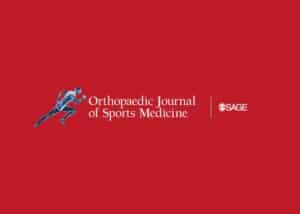
2019 AJSM
Complete radial tears of the medial meniscus have been functionally described as being similar to a total meniscectomy, and they represent a challenging problem to treat. Without treatment, radial tears of the medial meniscus can lead to rapid joint degeneration. Historically, radial tears were treated with partial or total meniscectomy, but many younger patients reported continued symptoms from joint overload and early knee arthritis. This patient population often needed further procedures, which ranged from meniscal transplantation as a salvage procedure to delay joint deterioration to early total knee replacement. With the unpredictable outcomes and high reoperation rates published for radial meniscal tear resection, a renewed push for repair of radial meniscal tears has emerged.
Historical techniques for the repair of radial meniscal tears involve either an all-inside horizontal mattress repair or an inside-out repair with single, double, or crossed horizontal mattress sutures. However, consistent healing of radial meniscal repairs with these techniques has not been found. A review of the biomechanical testing of these techniques suggests the need for novel repair techniques to improve the repair construct strength.
Two novel repair techniques for radial meniscal tears were recently reported in the literature. In 2012, Nakata reported on a novel technique for repair of radial meniscal tears that involved hybrid fixation, consisting of a configuration of vertical and horizontal mattress sutures across the radial tear site. In summary, the authors’ technique involves first placing nonabsorbable 2-0 vertical mat- tress sutures parallel to the radial tear site via an inside-out fashion. Next, 3 or 4 horizontal mattress sutures are placed perpendicular to, and over the top of, the vertical sutures to approximate the tear edges. At a mean follow-up of 18 months, 89% of patients were free from knee catching, locking, pain, or swelling. Second-look arthroscopy was performed at a mean 9 months after meniscal repair, and the authors reported that 66% of meniscal tears were completely healed, 28% were partially healed, and 7% failed.
In 2015, James presented a novel technique consisting of an inside-out horizontal mattress suture repair construct augmented with a 2-tunnel transtibial fixation to repair and anatomically reduce a radial meniscal tear. The authors presented a case report of a 29-year-old man who, at second-look arthroscopy, was confirmed to have complete healing of the entire radial meniscal tear. A follow-up study showed that this novel 2-tunnel technique was biomechanically superior to the traditional inside-out horizontal mattress suture repair technique. Clinical follow-up data on 27 patients treated with this technique reported comparable results between the 2-tunnel technique for repair of radial meniscal tears and inside-out repairs of vertical meniscal tears.
Therefore, the purpose of this study was to biomechanically compare 3 techniques for repair of radial tears of the medial meniscus: (1) an inside-out horizontal mattress suture repair construct augmented with a transtibial 2-tunnel suture fixation (‘‘2 tunnel’’), (2) a hybrid fixation with both a vertical and a horizontal mattress suture configuration (‘‘hybrid’’), and (3) a combined novel repair technique with vertical mattress sutures added to the transtibial repair technique (‘‘hybrid tunnel’’). We hypothesized that there would be no differences among the 3 groups in regard to gapping at the repair site and ultimate failure strength.
Full Article: Biomechanical Comparison of 3 Novel Repair Techniques for Radial Tears of the Medial Meniscus
